Leadership and Management Report: M&S Development Program Analysis
VerifiedAdded on 2020/10/05
|18
|5457
|471
Report
AI Summary
This report delves into the concepts of leadership and management, highlighting their differences and interdependencies. It examines the trait theory of leadership, identifying key characteristics that distinguish leaders. The report uses Marks & Spencer (M&S) as a case study, exploring its management development program and analyzing how it trains and develops employees in leadership. The analysis includes a comparison of leadership and management functions, objectives, and characteristics, along with an overview of the trait theory. The report further discusses the importance of leadership in driving employee performance and organizational productivity within the retail context of M&S.
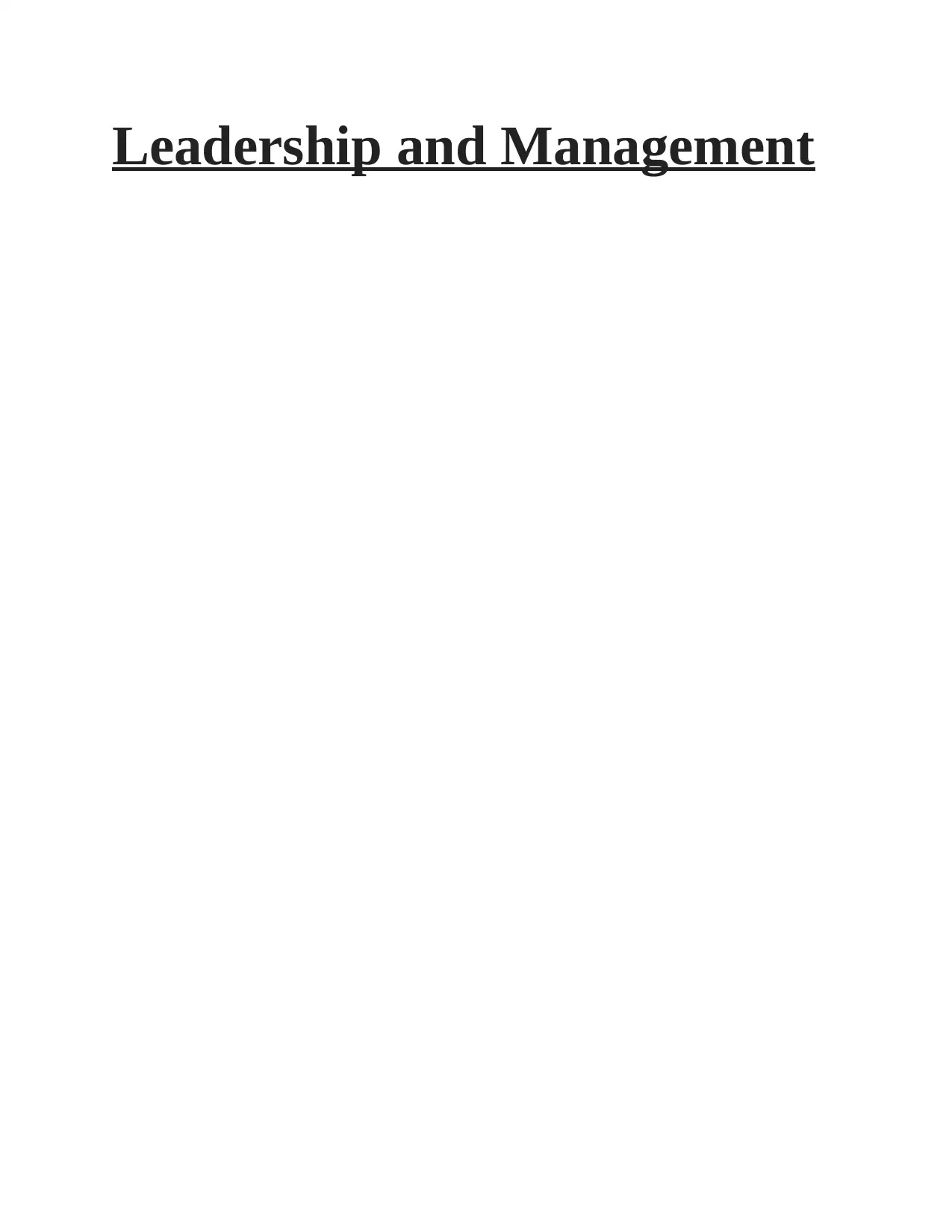
Leadership and Management
Paraphrase This Document
Need a fresh take? Get an instant paraphrase of this document with our AI Paraphraser
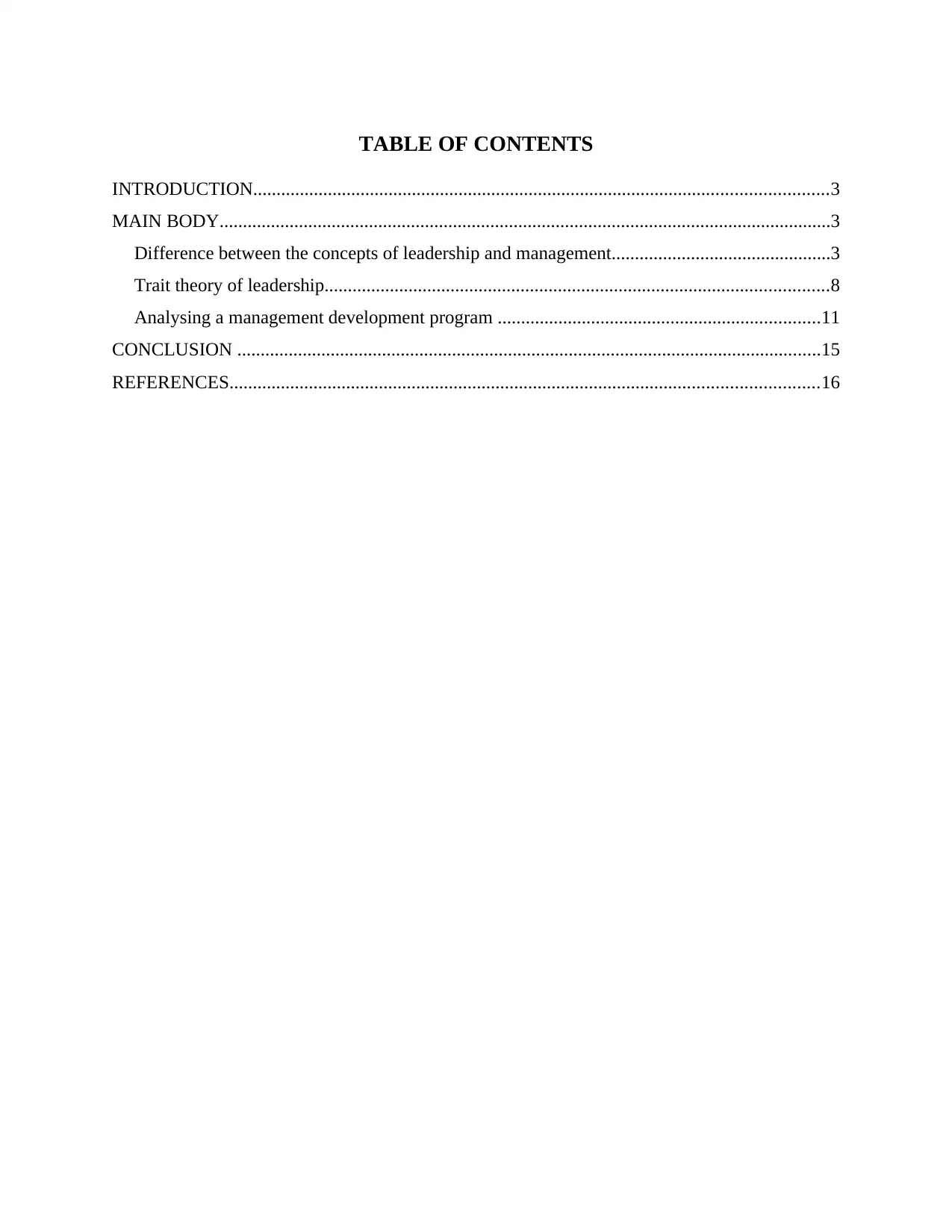
TABLE OF CONTENTS
INTRODUCTION...........................................................................................................................3
MAIN BODY...................................................................................................................................3
Difference between the concepts of leadership and management...............................................3
Trait theory of leadership............................................................................................................8
Analysing a management development program .....................................................................11
CONCLUSION .............................................................................................................................15
REFERENCES..............................................................................................................................16
INTRODUCTION...........................................................................................................................3
MAIN BODY...................................................................................................................................3
Difference between the concepts of leadership and management...............................................3
Trait theory of leadership............................................................................................................8
Analysing a management development program .....................................................................11
CONCLUSION .............................................................................................................................15
REFERENCES..............................................................................................................................16
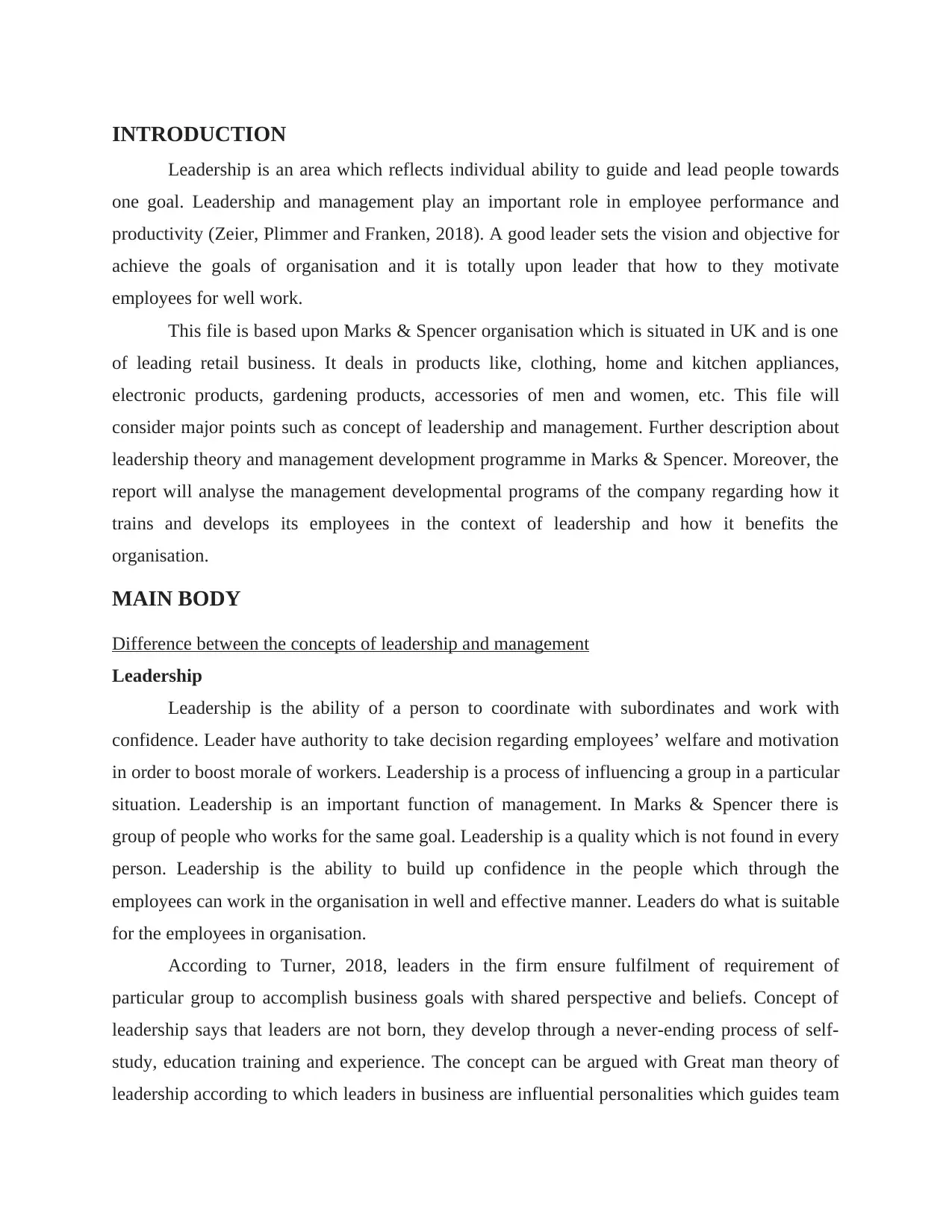
INTRODUCTION
Leadership is an area which reflects individual ability to guide and lead people towards
one goal. Leadership and management play an important role in employee performance and
productivity (Zeier, Plimmer and Franken, 2018). A good leader sets the vision and objective for
achieve the goals of organisation and it is totally upon leader that how to they motivate
employees for well work.
This file is based upon Marks & Spencer organisation which is situated in UK and is one
of leading retail business. It deals in products like, clothing, home and kitchen appliances,
electronic products, gardening products, accessories of men and women, etc. This file will
consider major points such as concept of leadership and management. Further description about
leadership theory and management development programme in Marks & Spencer. Moreover, the
report will analyse the management developmental programs of the company regarding how it
trains and develops its employees in the context of leadership and how it benefits the
organisation.
MAIN BODY
Difference between the concepts of leadership and management
Leadership
Leadership is the ability of a person to coordinate with subordinates and work with
confidence. Leader have authority to take decision regarding employees’ welfare and motivation
in order to boost morale of workers. Leadership is a process of influencing a group in a particular
situation. Leadership is an important function of management. In Marks & Spencer there is
group of people who works for the same goal. Leadership is a quality which is not found in every
person. Leadership is the ability to build up confidence in the people which through the
employees can work in the organisation in well and effective manner. Leaders do what is suitable
for the employees in organisation.
According to Turner, 2018, leaders in the firm ensure fulfilment of requirement of
particular group to accomplish business goals with shared perspective and beliefs. Concept of
leadership says that leaders are not born, they develop through a never-ending process of self-
study, education training and experience. The concept can be argued with Great man theory of
leadership according to which leaders in business are influential personalities which guides team
Leadership is an area which reflects individual ability to guide and lead people towards
one goal. Leadership and management play an important role in employee performance and
productivity (Zeier, Plimmer and Franken, 2018). A good leader sets the vision and objective for
achieve the goals of organisation and it is totally upon leader that how to they motivate
employees for well work.
This file is based upon Marks & Spencer organisation which is situated in UK and is one
of leading retail business. It deals in products like, clothing, home and kitchen appliances,
electronic products, gardening products, accessories of men and women, etc. This file will
consider major points such as concept of leadership and management. Further description about
leadership theory and management development programme in Marks & Spencer. Moreover, the
report will analyse the management developmental programs of the company regarding how it
trains and develops its employees in the context of leadership and how it benefits the
organisation.
MAIN BODY
Difference between the concepts of leadership and management
Leadership
Leadership is the ability of a person to coordinate with subordinates and work with
confidence. Leader have authority to take decision regarding employees’ welfare and motivation
in order to boost morale of workers. Leadership is a process of influencing a group in a particular
situation. Leadership is an important function of management. In Marks & Spencer there is
group of people who works for the same goal. Leadership is a quality which is not found in every
person. Leadership is the ability to build up confidence in the people which through the
employees can work in the organisation in well and effective manner. Leaders do what is suitable
for the employees in organisation.
According to Turner, 2018, leaders in the firm ensure fulfilment of requirement of
particular group to accomplish business goals with shared perspective and beliefs. Concept of
leadership says that leaders are not born, they develop through a never-ending process of self-
study, education training and experience. The concept can be argued with Great man theory of
leadership according to which leaders in business are influential personalities which guides team
⊘ This is a preview!⊘
Do you want full access?
Subscribe today to unlock all pages.

Trusted by 1+ million students worldwide
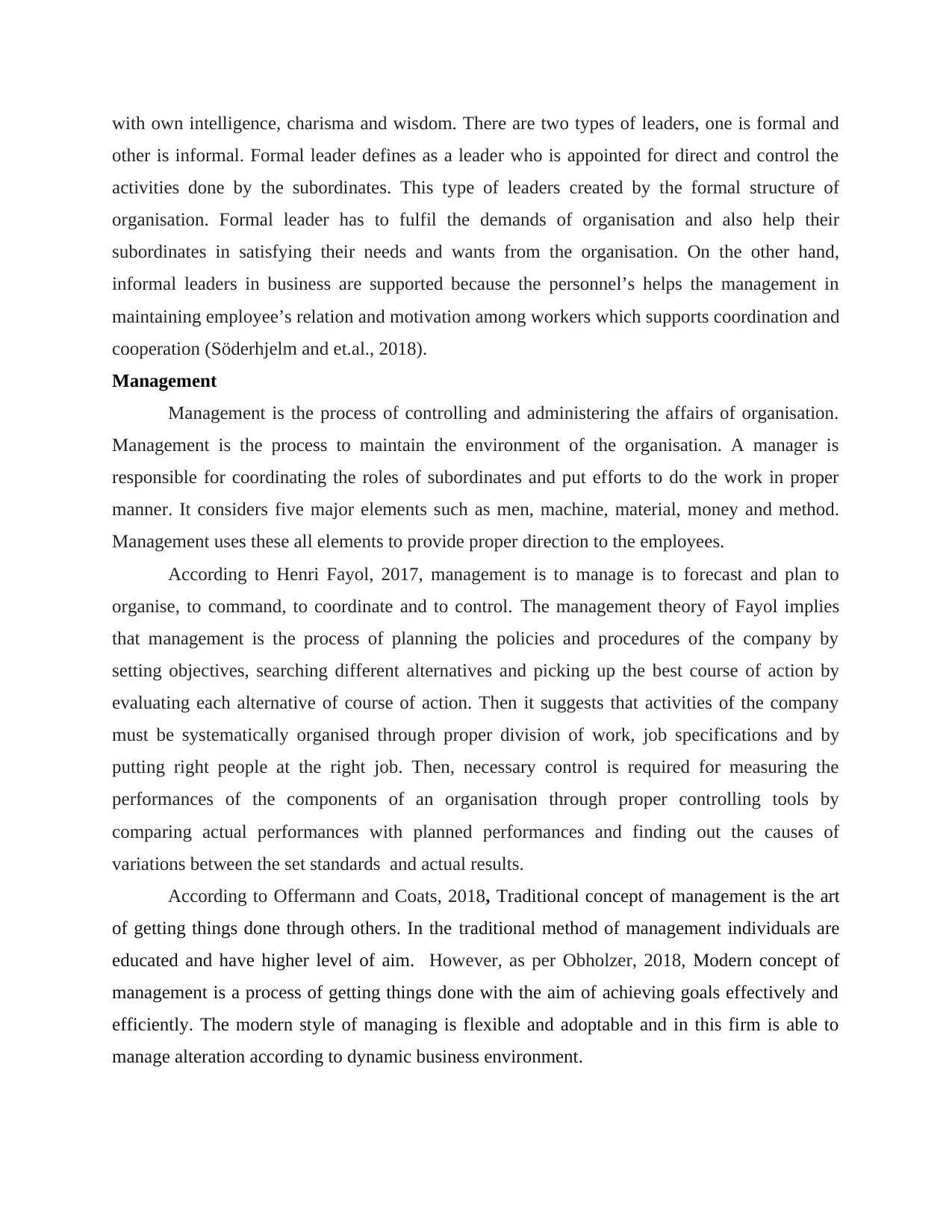
with own intelligence, charisma and wisdom. There are two types of leaders, one is formal and
other is informal. Formal leader defines as a leader who is appointed for direct and control the
activities done by the subordinates. This type of leaders created by the formal structure of
organisation. Formal leader has to fulfil the demands of organisation and also help their
subordinates in satisfying their needs and wants from the organisation. On the other hand,
informal leaders in business are supported because the personnel’s helps the management in
maintaining employee’s relation and motivation among workers which supports coordination and
cooperation (Söderhjelm and et.al., 2018).
Management
Management is the process of controlling and administering the affairs of organisation.
Management is the process to maintain the environment of the organisation. A manager is
responsible for coordinating the roles of subordinates and put efforts to do the work in proper
manner. It considers five major elements such as men, machine, material, money and method.
Management uses these all elements to provide proper direction to the employees.
According to Henri Fayol, 2017, management is to manage is to forecast and plan to
organise, to command, to coordinate and to control. The management theory of Fayol implies
that management is the process of planning the policies and procedures of the company by
setting objectives, searching different alternatives and picking up the best course of action by
evaluating each alternative of course of action. Then it suggests that activities of the company
must be systematically organised through proper division of work, job specifications and by
putting right people at the right job. Then, necessary control is required for measuring the
performances of the components of an organisation through proper controlling tools by
comparing actual performances with planned performances and finding out the causes of
variations between the set standards and actual results.
According to Offermann and Coats, 2018, Traditional concept of management is the art
of getting things done through others. In the traditional method of management individuals are
educated and have higher level of aim. However, as per Obholzer, 2018, Modern concept of
management is a process of getting things done with the aim of achieving goals effectively and
efficiently. The modern style of managing is flexible and adoptable and in this firm is able to
manage alteration according to dynamic business environment.
other is informal. Formal leader defines as a leader who is appointed for direct and control the
activities done by the subordinates. This type of leaders created by the formal structure of
organisation. Formal leader has to fulfil the demands of organisation and also help their
subordinates in satisfying their needs and wants from the organisation. On the other hand,
informal leaders in business are supported because the personnel’s helps the management in
maintaining employee’s relation and motivation among workers which supports coordination and
cooperation (Söderhjelm and et.al., 2018).
Management
Management is the process of controlling and administering the affairs of organisation.
Management is the process to maintain the environment of the organisation. A manager is
responsible for coordinating the roles of subordinates and put efforts to do the work in proper
manner. It considers five major elements such as men, machine, material, money and method.
Management uses these all elements to provide proper direction to the employees.
According to Henri Fayol, 2017, management is to manage is to forecast and plan to
organise, to command, to coordinate and to control. The management theory of Fayol implies
that management is the process of planning the policies and procedures of the company by
setting objectives, searching different alternatives and picking up the best course of action by
evaluating each alternative of course of action. Then it suggests that activities of the company
must be systematically organised through proper division of work, job specifications and by
putting right people at the right job. Then, necessary control is required for measuring the
performances of the components of an organisation through proper controlling tools by
comparing actual performances with planned performances and finding out the causes of
variations between the set standards and actual results.
According to Offermann and Coats, 2018, Traditional concept of management is the art
of getting things done through others. In the traditional method of management individuals are
educated and have higher level of aim. However, as per Obholzer, 2018, Modern concept of
management is a process of getting things done with the aim of achieving goals effectively and
efficiently. The modern style of managing is flexible and adoptable and in this firm is able to
manage alteration according to dynamic business environment.
Paraphrase This Document
Need a fresh take? Get an instant paraphrase of this document with our AI Paraphraser
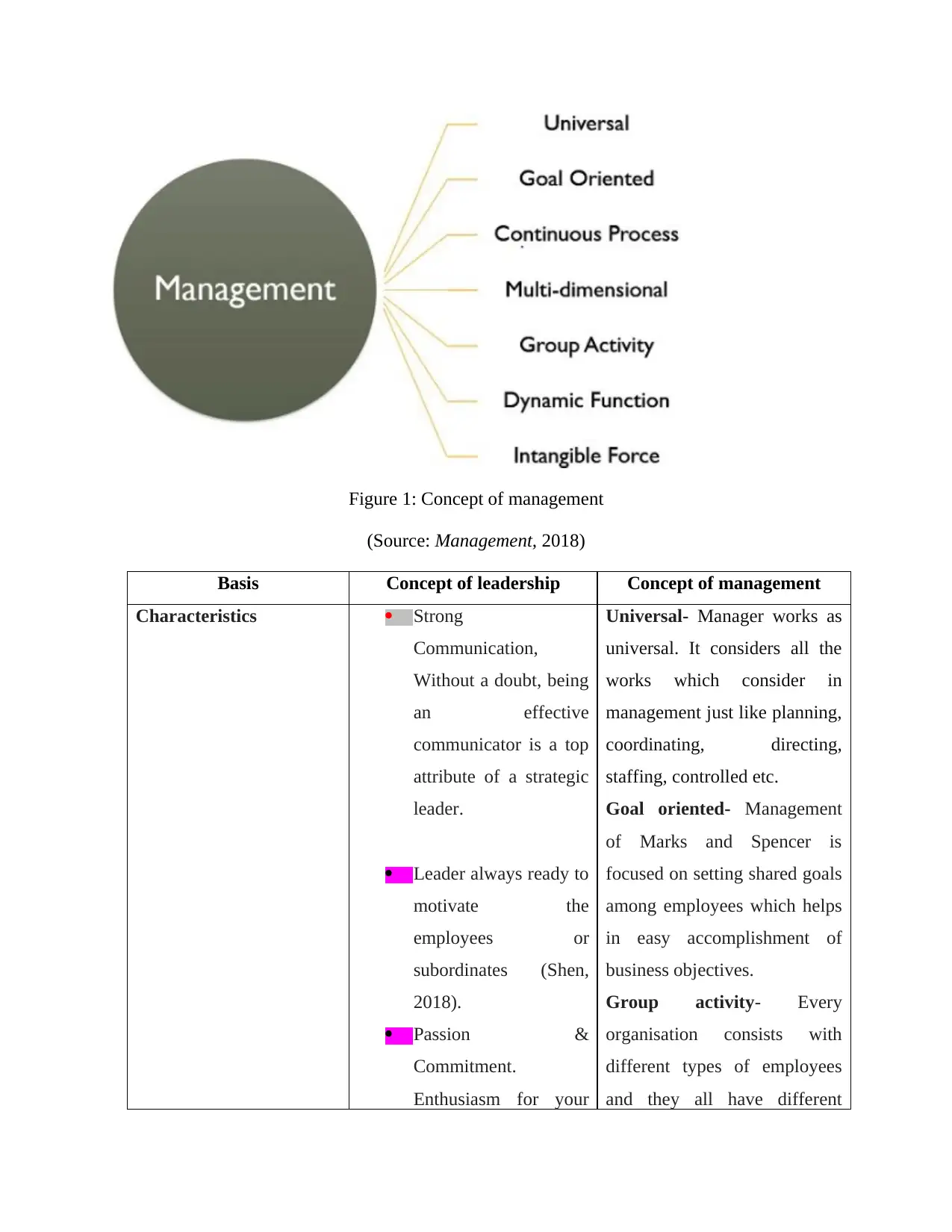
Figure 1: Concept of management
(Source: Management, 2018)
Basis Concept of leadership Concept of management
Characteristics Strong
Communication,
Without a doubt, being
an effective
communicator is a top
attribute of a strategic
leader.
Leader always ready to
motivate the
employees or
subordinates (Shen,
2018).
Passion &
Commitment.
Enthusiasm for your
Universal- Manager works as
universal. It considers all the
works which consider in
management just like planning,
coordinating, directing,
staffing, controlled etc.
Goal oriented- Management
of Marks and Spencer is
focused on setting shared goals
among employees which helps
in easy accomplishment of
business objectives.
Group activity- Every
organisation consists with
different types of employees
and they all have different
(Source: Management, 2018)
Basis Concept of leadership Concept of management
Characteristics Strong
Communication,
Without a doubt, being
an effective
communicator is a top
attribute of a strategic
leader.
Leader always ready to
motivate the
employees or
subordinates (Shen,
2018).
Passion &
Commitment.
Enthusiasm for your
Universal- Manager works as
universal. It considers all the
works which consider in
management just like planning,
coordinating, directing,
staffing, controlled etc.
Goal oriented- Management
of Marks and Spencer is
focused on setting shared goals
among employees which helps
in easy accomplishment of
business objectives.
Group activity- Every
organisation consists with
different types of employees
and they all have different
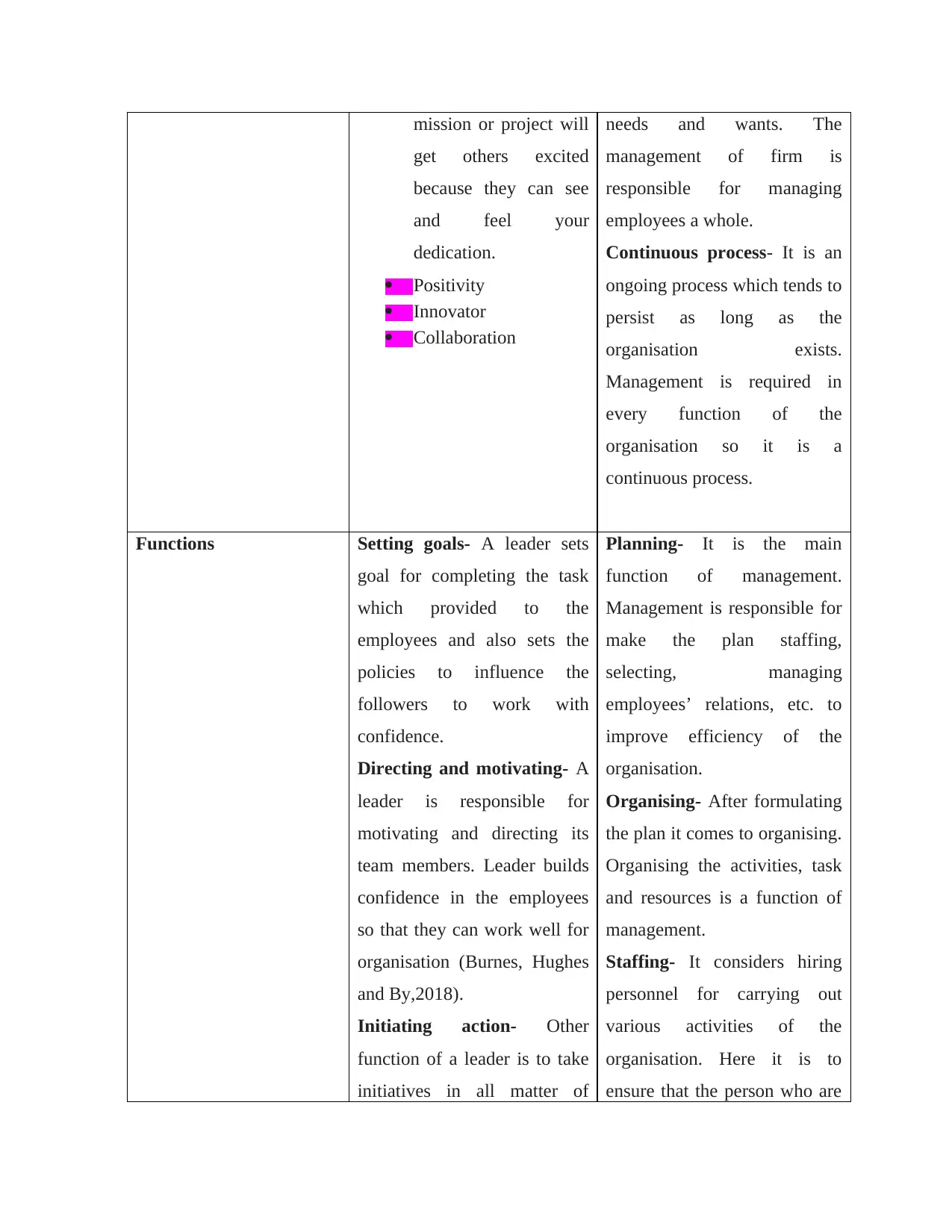
mission or project will
get others excited
because they can see
and feel your
dedication.
Positivity
Innovator
Collaboration
needs and wants. The
management of firm is
responsible for managing
employees a whole.
Continuous process- It is an
ongoing process which tends to
persist as long as the
organisation exists.
Management is required in
every function of the
organisation so it is a
continuous process.
Functions Setting goals- A leader sets
goal for completing the task
which provided to the
employees and also sets the
policies to influence the
followers to work with
confidence.
Directing and motivating- A
leader is responsible for
motivating and directing its
team members. Leader builds
confidence in the employees
so that they can work well for
organisation (Burnes, Hughes
and By,2018).
Initiating action- Other
function of a leader is to take
initiatives in all matter of
Planning- It is the main
function of management.
Management is responsible for
make the plan staffing,
selecting, managing
employees’ relations, etc. to
improve efficiency of the
organisation.
Organising- After formulating
the plan it comes to organising.
Organising the activities, task
and resources is a function of
management.
Staffing- It considers hiring
personnel for carrying out
various activities of the
organisation. Here it is to
ensure that the person who are
get others excited
because they can see
and feel your
dedication.
Positivity
Innovator
Collaboration
needs and wants. The
management of firm is
responsible for managing
employees a whole.
Continuous process- It is an
ongoing process which tends to
persist as long as the
organisation exists.
Management is required in
every function of the
organisation so it is a
continuous process.
Functions Setting goals- A leader sets
goal for completing the task
which provided to the
employees and also sets the
policies to influence the
followers to work with
confidence.
Directing and motivating- A
leader is responsible for
motivating and directing its
team members. Leader builds
confidence in the employees
so that they can work well for
organisation (Burnes, Hughes
and By,2018).
Initiating action- Other
function of a leader is to take
initiatives in all matter of
Planning- It is the main
function of management.
Management is responsible for
make the plan staffing,
selecting, managing
employees’ relations, etc. to
improve efficiency of the
organisation.
Organising- After formulating
the plan it comes to organising.
Organising the activities, task
and resources is a function of
management.
Staffing- It considers hiring
personnel for carrying out
various activities of the
organisation. Here it is to
ensure that the person who are
⊘ This is a preview!⊘
Do you want full access?
Subscribe today to unlock all pages.

Trusted by 1+ million students worldwide
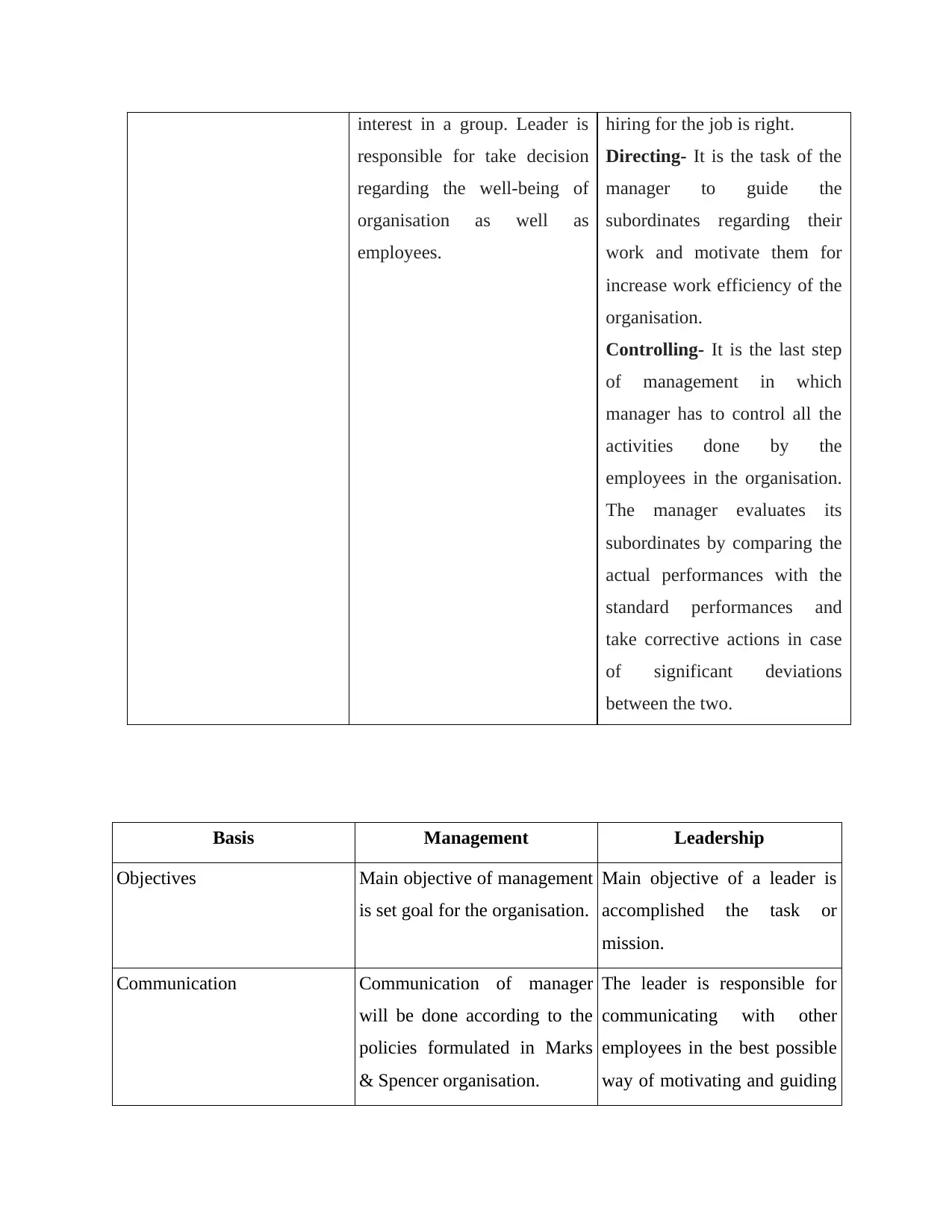
interest in a group. Leader is
responsible for take decision
regarding the well-being of
organisation as well as
employees.
hiring for the job is right.
Directing- It is the task of the
manager to guide the
subordinates regarding their
work and motivate them for
increase work efficiency of the
organisation.
Controlling- It is the last step
of management in which
manager has to control all the
activities done by the
employees in the organisation.
The manager evaluates its
subordinates by comparing the
actual performances with the
standard performances and
take corrective actions in case
of significant deviations
between the two.
Basis Management Leadership
Objectives Main objective of management
is set goal for the organisation.
Main objective of a leader is
accomplished the task or
mission.
Communication Communication of manager
will be done according to the
policies formulated in Marks
& Spencer organisation.
The leader is responsible for
communicating with other
employees in the best possible
way of motivating and guiding
responsible for take decision
regarding the well-being of
organisation as well as
employees.
hiring for the job is right.
Directing- It is the task of the
manager to guide the
subordinates regarding their
work and motivate them for
increase work efficiency of the
organisation.
Controlling- It is the last step
of management in which
manager has to control all the
activities done by the
employees in the organisation.
The manager evaluates its
subordinates by comparing the
actual performances with the
standard performances and
take corrective actions in case
of significant deviations
between the two.
Basis Management Leadership
Objectives Main objective of management
is set goal for the organisation.
Main objective of a leader is
accomplished the task or
mission.
Communication Communication of manager
will be done according to the
policies formulated in Marks
& Spencer organisation.
The leader is responsible for
communicating with other
employees in the best possible
way of motivating and guiding
Paraphrase This Document
Need a fresh take? Get an instant paraphrase of this document with our AI Paraphraser
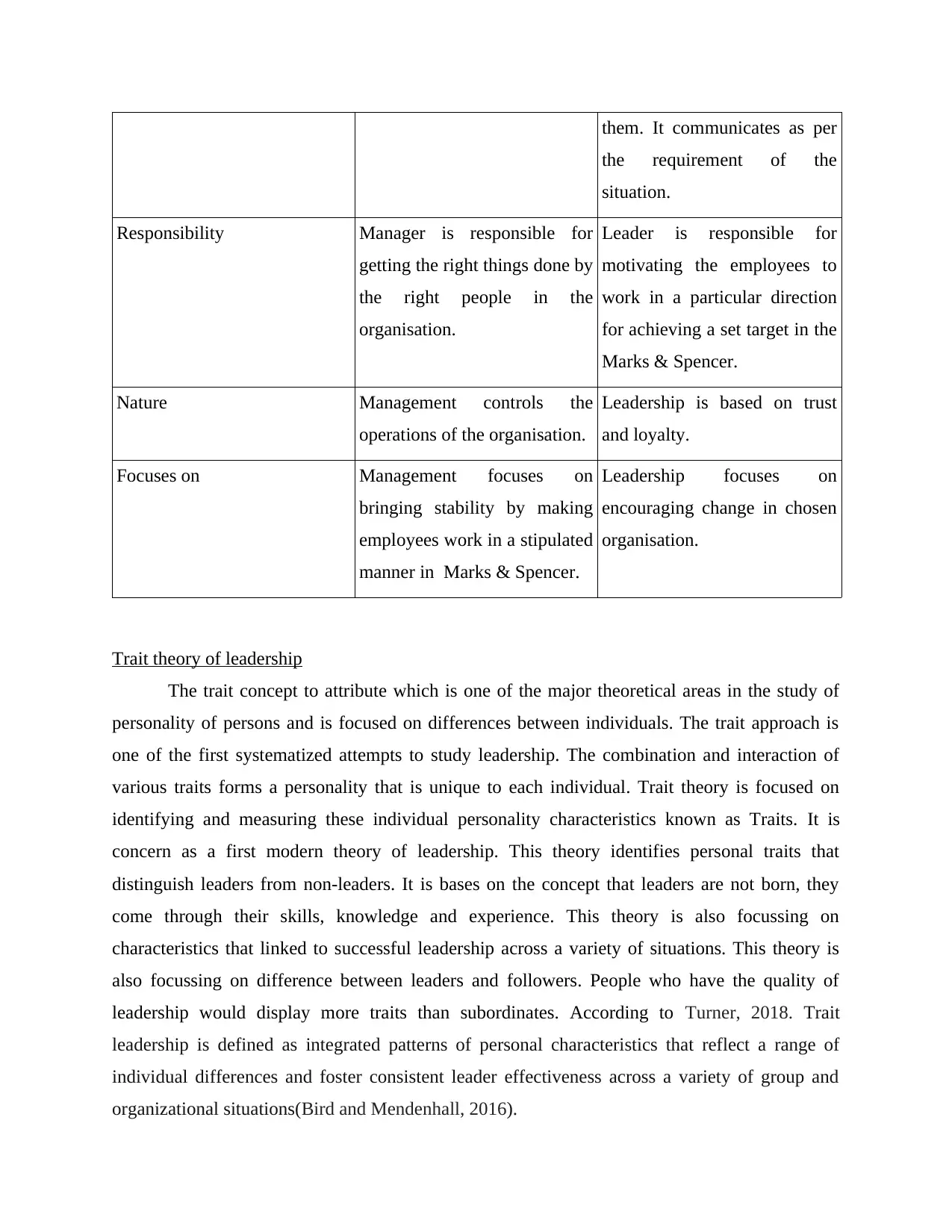
them. It communicates as per
the requirement of the
situation.
Responsibility Manager is responsible for
getting the right things done by
the right people in the
organisation.
Leader is responsible for
motivating the employees to
work in a particular direction
for achieving a set target in the
Marks & Spencer.
Nature Management controls the
operations of the organisation.
Leadership is based on trust
and loyalty.
Focuses on Management focuses on
bringing stability by making
employees work in a stipulated
manner in Marks & Spencer.
Leadership focuses on
encouraging change in chosen
organisation.
Trait theory of leadership
The trait concept to attribute which is one of the major theoretical areas in the study of
personality of persons and is focused on differences between individuals. The trait approach is
one of the first systematized attempts to study leadership. The combination and interaction of
various traits forms a personality that is unique to each individual. Trait theory is focused on
identifying and measuring these individual personality characteristics known as Traits. It is
concern as a first modern theory of leadership. This theory identifies personal traits that
distinguish leaders from non-leaders. It is bases on the concept that leaders are not born, they
come through their skills, knowledge and experience. This theory is also focussing on
characteristics that linked to successful leadership across a variety of situations. This theory is
also focussing on difference between leaders and followers. People who have the quality of
leadership would display more traits than subordinates. According to Turner, 2018. Trait
leadership is defined as integrated patterns of personal characteristics that reflect a range of
individual differences and foster consistent leader effectiveness across a variety of group and
organizational situations(Bird and Mendenhall, 2016).
the requirement of the
situation.
Responsibility Manager is responsible for
getting the right things done by
the right people in the
organisation.
Leader is responsible for
motivating the employees to
work in a particular direction
for achieving a set target in the
Marks & Spencer.
Nature Management controls the
operations of the organisation.
Leadership is based on trust
and loyalty.
Focuses on Management focuses on
bringing stability by making
employees work in a stipulated
manner in Marks & Spencer.
Leadership focuses on
encouraging change in chosen
organisation.
Trait theory of leadership
The trait concept to attribute which is one of the major theoretical areas in the study of
personality of persons and is focused on differences between individuals. The trait approach is
one of the first systematized attempts to study leadership. The combination and interaction of
various traits forms a personality that is unique to each individual. Trait theory is focused on
identifying and measuring these individual personality characteristics known as Traits. It is
concern as a first modern theory of leadership. This theory identifies personal traits that
distinguish leaders from non-leaders. It is bases on the concept that leaders are not born, they
come through their skills, knowledge and experience. This theory is also focussing on
characteristics that linked to successful leadership across a variety of situations. This theory is
also focussing on difference between leaders and followers. People who have the quality of
leadership would display more traits than subordinates. According to Turner, 2018. Trait
leadership is defined as integrated patterns of personal characteristics that reflect a range of
individual differences and foster consistent leader effectiveness across a variety of group and
organizational situations(Bird and Mendenhall, 2016).
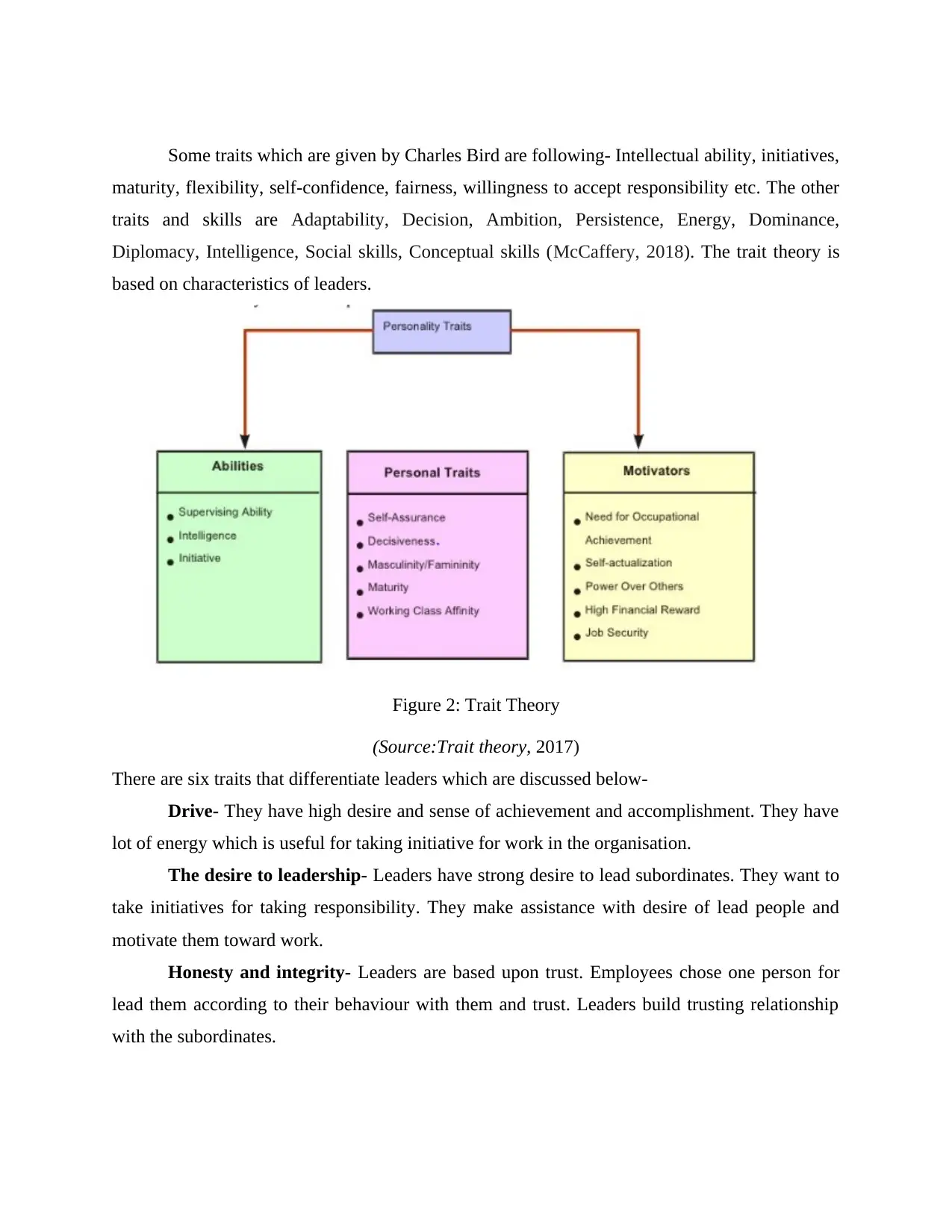
Some traits which are given by Charles Bird are following- Intellectual ability, initiatives,
maturity, flexibility, self-confidence, fairness, willingness to accept responsibility etc. The other
traits and skills are Adaptability, Decision, Ambition, Persistence, Energy, Dominance,
Diplomacy, Intelligence, Social skills, Conceptual skills (McCaffery, 2018). The trait theory is
based on characteristics of leaders.
Figure 2: Trait Theory
(Source:Trait theory, 2017)
There are six traits that differentiate leaders which are discussed below-
Drive- They have high desire and sense of achievement and accomplishment. They have
lot of energy which is useful for taking initiative for work in the organisation.
The desire to leadership- Leaders have strong desire to lead subordinates. They want to
take initiatives for taking responsibility. They make assistance with desire of lead people and
motivate them toward work.
Honesty and integrity- Leaders are based upon trust. Employees chose one person for
lead them according to their behaviour with them and trust. Leaders build trusting relationship
with the subordinates.
maturity, flexibility, self-confidence, fairness, willingness to accept responsibility etc. The other
traits and skills are Adaptability, Decision, Ambition, Persistence, Energy, Dominance,
Diplomacy, Intelligence, Social skills, Conceptual skills (McCaffery, 2018). The trait theory is
based on characteristics of leaders.
Figure 2: Trait Theory
(Source:Trait theory, 2017)
There are six traits that differentiate leaders which are discussed below-
Drive- They have high desire and sense of achievement and accomplishment. They have
lot of energy which is useful for taking initiative for work in the organisation.
The desire to leadership- Leaders have strong desire to lead subordinates. They want to
take initiatives for taking responsibility. They make assistance with desire of lead people and
motivate them toward work.
Honesty and integrity- Leaders are based upon trust. Employees chose one person for
lead them according to their behaviour with them and trust. Leaders build trusting relationship
with the subordinates.
⊘ This is a preview!⊘
Do you want full access?
Subscribe today to unlock all pages.

Trusted by 1+ million students worldwide
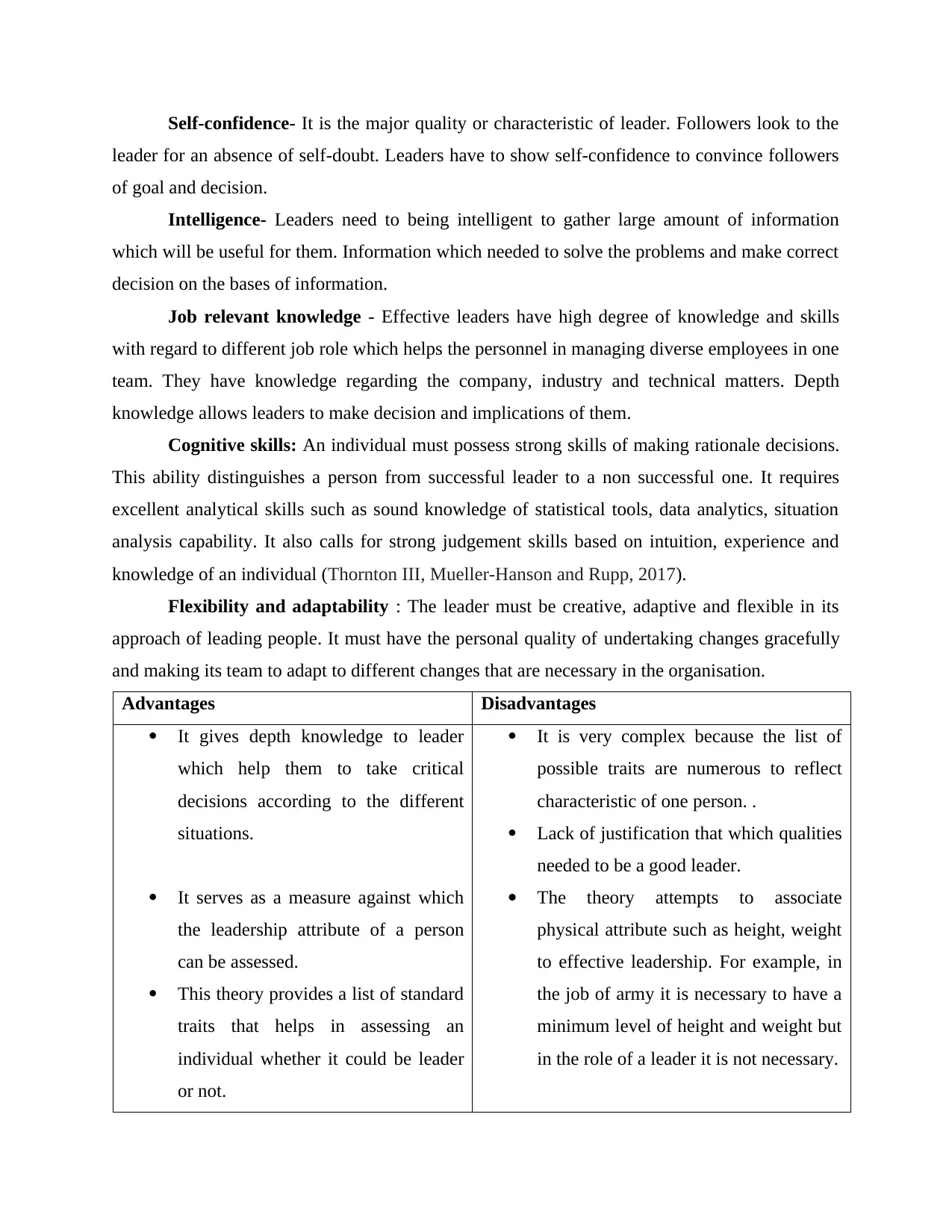
Self-confidence- It is the major quality or characteristic of leader. Followers look to the
leader for an absence of self-doubt. Leaders have to show self-confidence to convince followers
of goal and decision.
Intelligence- Leaders need to being intelligent to gather large amount of information
which will be useful for them. Information which needed to solve the problems and make correct
decision on the bases of information.
Job relevant knowledge - Effective leaders have high degree of knowledge and skills
with regard to different job role which helps the personnel in managing diverse employees in one
team. They have knowledge regarding the company, industry and technical matters. Depth
knowledge allows leaders to make decision and implications of them.
Cognitive skills: An individual must possess strong skills of making rationale decisions.
This ability distinguishes a person from successful leader to a non successful one. It requires
excellent analytical skills such as sound knowledge of statistical tools, data analytics, situation
analysis capability. It also calls for strong judgement skills based on intuition, experience and
knowledge of an individual (Thornton III, Mueller-Hanson and Rupp, 2017).
Flexibility and adaptability : The leader must be creative, adaptive and flexible in its
approach of leading people. It must have the personal quality of undertaking changes gracefully
and making its team to adapt to different changes that are necessary in the organisation.
Advantages Disadvantages
It gives depth knowledge to leader
which help them to take critical
decisions according to the different
situations.
It serves as a measure against which
the leadership attribute of a person
can be assessed.
This theory provides a list of standard
traits that helps in assessing an
individual whether it could be leader
or not.
It is very complex because the list of
possible traits are numerous to reflect
characteristic of one person. .
Lack of justification that which qualities
needed to be a good leader.
The theory attempts to associate
physical attribute such as height, weight
to effective leadership. For example, in
the job of army it is necessary to have a
minimum level of height and weight but
in the role of a leader it is not necessary.
leader for an absence of self-doubt. Leaders have to show self-confidence to convince followers
of goal and decision.
Intelligence- Leaders need to being intelligent to gather large amount of information
which will be useful for them. Information which needed to solve the problems and make correct
decision on the bases of information.
Job relevant knowledge - Effective leaders have high degree of knowledge and skills
with regard to different job role which helps the personnel in managing diverse employees in one
team. They have knowledge regarding the company, industry and technical matters. Depth
knowledge allows leaders to make decision and implications of them.
Cognitive skills: An individual must possess strong skills of making rationale decisions.
This ability distinguishes a person from successful leader to a non successful one. It requires
excellent analytical skills such as sound knowledge of statistical tools, data analytics, situation
analysis capability. It also calls for strong judgement skills based on intuition, experience and
knowledge of an individual (Thornton III, Mueller-Hanson and Rupp, 2017).
Flexibility and adaptability : The leader must be creative, adaptive and flexible in its
approach of leading people. It must have the personal quality of undertaking changes gracefully
and making its team to adapt to different changes that are necessary in the organisation.
Advantages Disadvantages
It gives depth knowledge to leader
which help them to take critical
decisions according to the different
situations.
It serves as a measure against which
the leadership attribute of a person
can be assessed.
This theory provides a list of standard
traits that helps in assessing an
individual whether it could be leader
or not.
It is very complex because the list of
possible traits are numerous to reflect
characteristic of one person. .
Lack of justification that which qualities
needed to be a good leader.
The theory attempts to associate
physical attribute such as height, weight
to effective leadership. For example, in
the job of army it is necessary to have a
minimum level of height and weight but
in the role of a leader it is not necessary.
Paraphrase This Document
Need a fresh take? Get an instant paraphrase of this document with our AI Paraphraser
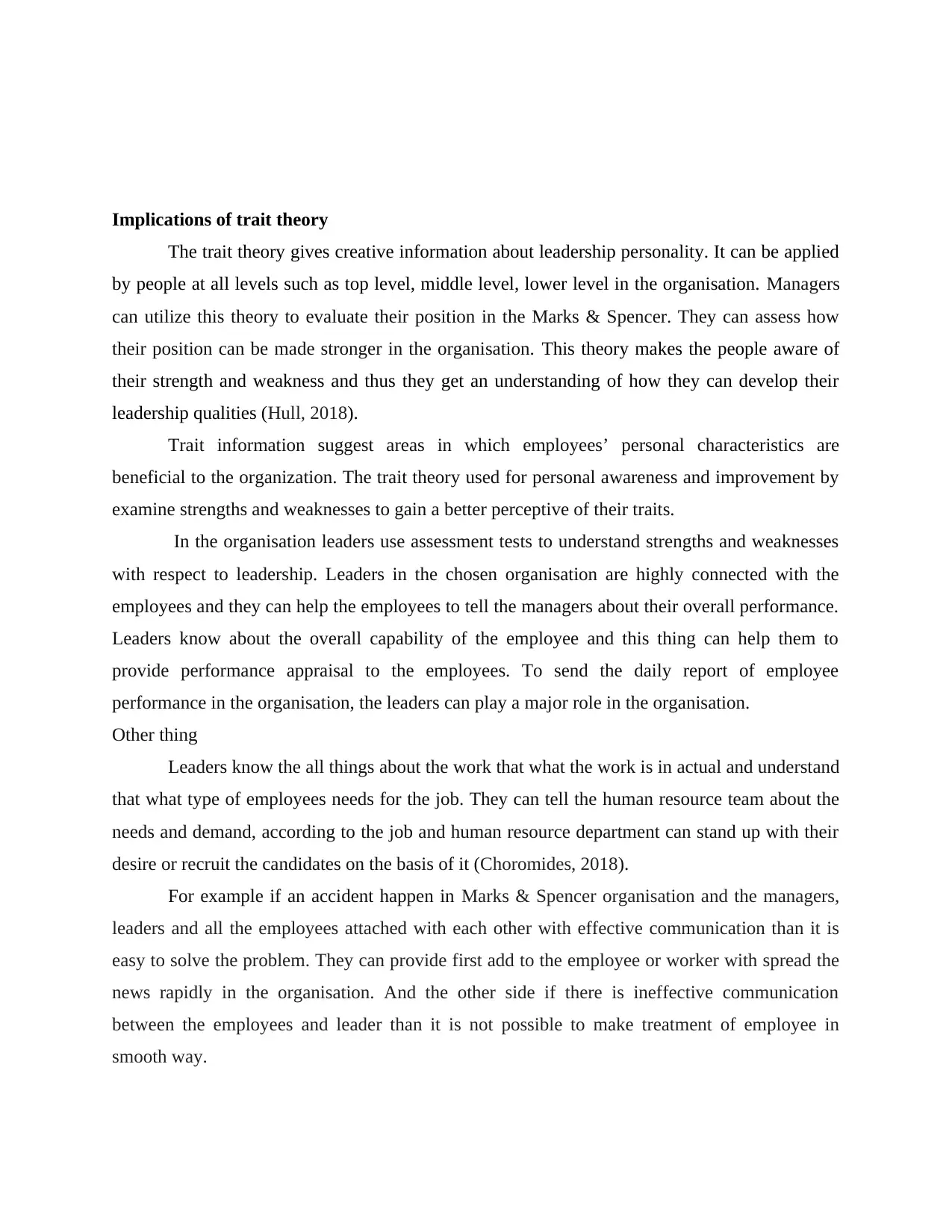
Implications of trait theory
The trait theory gives creative information about leadership personality. It can be applied
by people at all levels such as top level, middle level, lower level in the organisation. Managers
can utilize this theory to evaluate their position in the Marks & Spencer. They can assess how
their position can be made stronger in the organisation. This theory makes the people aware of
their strength and weakness and thus they get an understanding of how they can develop their
leadership qualities (Hull, 2018).
Trait information suggest areas in which employees’ personal characteristics are
beneficial to the organization. The trait theory used for personal awareness and improvement by
examine strengths and weaknesses to gain a better perceptive of their traits.
In the organisation leaders use assessment tests to understand strengths and weaknesses
with respect to leadership. Leaders in the chosen organisation are highly connected with the
employees and they can help the employees to tell the managers about their overall performance.
Leaders know about the overall capability of the employee and this thing can help them to
provide performance appraisal to the employees. To send the daily report of employee
performance in the organisation, the leaders can play a major role in the organisation.
Other thing
Leaders know the all things about the work that what the work is in actual and understand
that what type of employees needs for the job. They can tell the human resource team about the
needs and demand, according to the job and human resource department can stand up with their
desire or recruit the candidates on the basis of it (Choromides, 2018).
For example if an accident happen in Marks & Spencer organisation and the managers,
leaders and all the employees attached with each other with effective communication than it is
easy to solve the problem. They can provide first add to the employee or worker with spread the
news rapidly in the organisation. And the other side if there is ineffective communication
between the employees and leader than it is not possible to make treatment of employee in
smooth way.
The trait theory gives creative information about leadership personality. It can be applied
by people at all levels such as top level, middle level, lower level in the organisation. Managers
can utilize this theory to evaluate their position in the Marks & Spencer. They can assess how
their position can be made stronger in the organisation. This theory makes the people aware of
their strength and weakness and thus they get an understanding of how they can develop their
leadership qualities (Hull, 2018).
Trait information suggest areas in which employees’ personal characteristics are
beneficial to the organization. The trait theory used for personal awareness and improvement by
examine strengths and weaknesses to gain a better perceptive of their traits.
In the organisation leaders use assessment tests to understand strengths and weaknesses
with respect to leadership. Leaders in the chosen organisation are highly connected with the
employees and they can help the employees to tell the managers about their overall performance.
Leaders know about the overall capability of the employee and this thing can help them to
provide performance appraisal to the employees. To send the daily report of employee
performance in the organisation, the leaders can play a major role in the organisation.
Other thing
Leaders know the all things about the work that what the work is in actual and understand
that what type of employees needs for the job. They can tell the human resource team about the
needs and demand, according to the job and human resource department can stand up with their
desire or recruit the candidates on the basis of it (Choromides, 2018).
For example if an accident happen in Marks & Spencer organisation and the managers,
leaders and all the employees attached with each other with effective communication than it is
easy to solve the problem. They can provide first add to the employee or worker with spread the
news rapidly in the organisation. And the other side if there is ineffective communication
between the employees and leader than it is not possible to make treatment of employee in
smooth way.
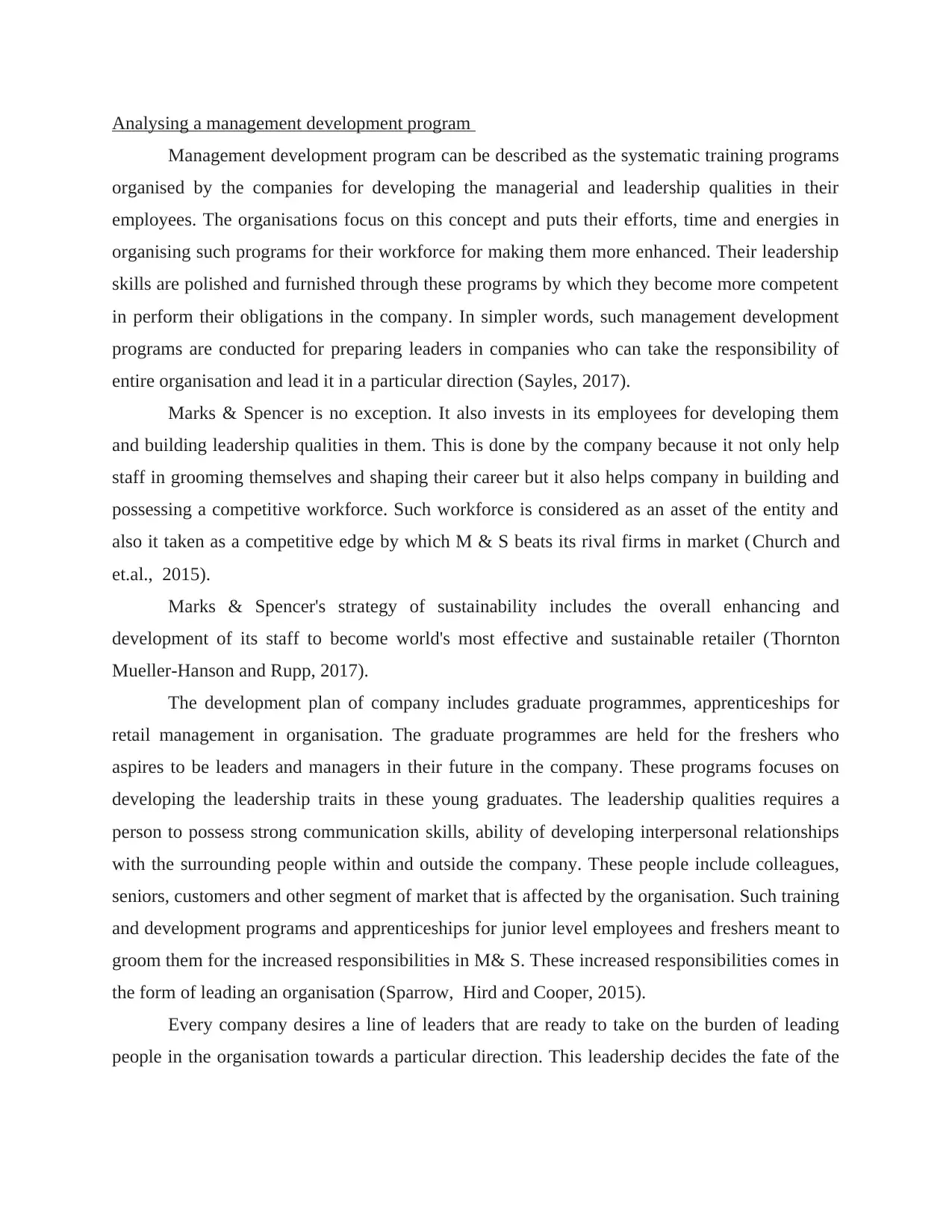
Analysing a management development program
Management development program can be described as the systematic training programs
organised by the companies for developing the managerial and leadership qualities in their
employees. The organisations focus on this concept and puts their efforts, time and energies in
organising such programs for their workforce for making them more enhanced. Their leadership
skills are polished and furnished through these programs by which they become more competent
in perform their obligations in the company. In simpler words, such management development
programs are conducted for preparing leaders in companies who can take the responsibility of
entire organisation and lead it in a particular direction (Sayles, 2017).
Marks & Spencer is no exception. It also invests in its employees for developing them
and building leadership qualities in them. This is done by the company because it not only help
staff in grooming themselves and shaping their career but it also helps company in building and
possessing a competitive workforce. Such workforce is considered as an asset of the entity and
also it taken as a competitive edge by which M & S beats its rival firms in market (Church and
et.al., 2015).
Marks & Spencer's strategy of sustainability includes the overall enhancing and
development of its staff to become world's most effective and sustainable retailer (Thornton
Mueller-Hanson and Rupp, 2017).
The development plan of company includes graduate programmes, apprenticeships for
retail management in organisation. The graduate programmes are held for the freshers who
aspires to be leaders and managers in their future in the company. These programs focuses on
developing the leadership traits in these young graduates. The leadership qualities requires a
person to possess strong communication skills, ability of developing interpersonal relationships
with the surrounding people within and outside the company. These people include colleagues,
seniors, customers and other segment of market that is affected by the organisation. Such training
and development programs and apprenticeships for junior level employees and freshers meant to
groom them for the increased responsibilities in M& S. These increased responsibilities comes in
the form of leading an organisation (Sparrow, Hird and Cooper, 2015).
Every company desires a line of leaders that are ready to take on the burden of leading
people in the organisation towards a particular direction. This leadership decides the fate of the
Management development program can be described as the systematic training programs
organised by the companies for developing the managerial and leadership qualities in their
employees. The organisations focus on this concept and puts their efforts, time and energies in
organising such programs for their workforce for making them more enhanced. Their leadership
skills are polished and furnished through these programs by which they become more competent
in perform their obligations in the company. In simpler words, such management development
programs are conducted for preparing leaders in companies who can take the responsibility of
entire organisation and lead it in a particular direction (Sayles, 2017).
Marks & Spencer is no exception. It also invests in its employees for developing them
and building leadership qualities in them. This is done by the company because it not only help
staff in grooming themselves and shaping their career but it also helps company in building and
possessing a competitive workforce. Such workforce is considered as an asset of the entity and
also it taken as a competitive edge by which M & S beats its rival firms in market (Church and
et.al., 2015).
Marks & Spencer's strategy of sustainability includes the overall enhancing and
development of its staff to become world's most effective and sustainable retailer (Thornton
Mueller-Hanson and Rupp, 2017).
The development plan of company includes graduate programmes, apprenticeships for
retail management in organisation. The graduate programmes are held for the freshers who
aspires to be leaders and managers in their future in the company. These programs focuses on
developing the leadership traits in these young graduates. The leadership qualities requires a
person to possess strong communication skills, ability of developing interpersonal relationships
with the surrounding people within and outside the company. These people include colleagues,
seniors, customers and other segment of market that is affected by the organisation. Such training
and development programs and apprenticeships for junior level employees and freshers meant to
groom them for the increased responsibilities in M& S. These increased responsibilities comes in
the form of leading an organisation (Sparrow, Hird and Cooper, 2015).
Every company desires a line of leaders that are ready to take on the burden of leading
people in the organisation towards a particular direction. This leadership decides the fate of the
⊘ This is a preview!⊘
Do you want full access?
Subscribe today to unlock all pages.

Trusted by 1+ million students worldwide
1 out of 18
Related Documents
Your All-in-One AI-Powered Toolkit for Academic Success.
+13062052269
info@desklib.com
Available 24*7 on WhatsApp / Email
![[object Object]](/_next/static/media/star-bottom.7253800d.svg)
Unlock your academic potential
Copyright © 2020–2025 A2Z Services. All Rights Reserved. Developed and managed by ZUCOL.





